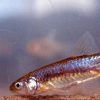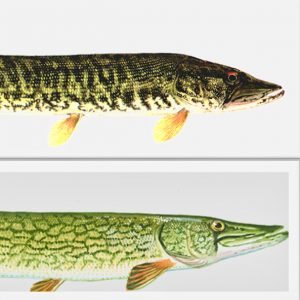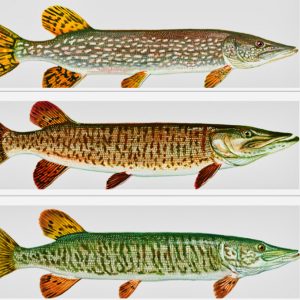calsfoundation@cals.org
Esocids
aka: Pikes
Esocids belong to the order Esociformes and family Esocidae. They were endemic to the Northern Hemisphere of North America and Eurasia during the Paleogene (66 to 23 million years before present). The only living genus is Esox (pikes and pickerels) and it includes seven species; four of those species occur in North America, and five (one introduction) of the seven can be found in Europe and Asia. In the United States, the natural range of esocids is restricted to regions east of the Rockies; however, many introductions have been made in the west. In Arkansas, there are four species: the grass pickerel (Esox americanus), northern pike (E. lucius), muskellunge (E. masquinongy), and chain pickerel (E. niger). Two of these, E. lucius and E. masquinongy, are non-native and were introduced into the state to help broaden recreational fishing opportunities. In addition, the tiger muskellunge (E. lucius × E. masquinongy), a hybrid cross between northern pike and muskellunge, has been stocked into Arkansas.
One fossil species is known from the Eocene of the Green River formation of Colorado, Utah, and Wyoming. There are also two additional fossil species of Esocidae placed in their own genera.
In general, esocids have an elongated, torpedo-like predatory fish body with a sharply pointed head, a duck-billed snout, sharp teeth, a weakly developed lateral line, soft rayed fins, a single posteriorly positioned dorsal fin, a forked caudal fin, and small smooth-edged cycloid scales. A frenum (bridge of skin) is present on the upper jaw where it is joined to the snout at the middle. Their coloration is typically gray-green with a mottled or spotted appearance and stripes along their backs, providing camouflage among weeds. Pike can grow to a maximum recorded length of 1.8 meters (6 feet), reaching a maximum recorded weight of 35 kilograms (77 pounds).
Esocids are predatory “lie-in-wait” fish that feed on a wide variety of food items, predominantly smaller shoal fishes, particularly shad, but also centrarchids. They will also prey on insects, leeches, amphibians, watersnakes, turtles, ducklings, and, occasionally, small water-borne rodents. Pike are also reported to be cannibalistic, sometimes preying upon smaller members of their own species; this has been often observed in E. lucius.
Esocids are prized by anglers and have a reputation for their fighting ability. They can be caught with dead or live baits and lures. However, fishermen must use extreme care when unhooking them, since pike possess numerous sharp teeth. The taste of esocids is highly valued, but there are many long, fine, forked intermuscular bones that can be problematic. In Europe, a delicacy called quenelles de brochet (pike dumplings) is prepared by putting the meat through a sieve to help remove these bones. Fried or baked pike is said to be delicious, with a flaky texture.
Pikes and pickerels reproduce randomly in late winter and early spring. Parents do not prepare a nest, and eggs are adhesive and scattered over vegetation or substrate debris. There is no parental care of the eggs nor of the fry.
The grass pickerel (E. americanus) is currently divided into two subspecies, E. a. americanus (or redfin pickerel) and E. a. vermiculatus (grass pickerel). The later subspecies occurs in Arkansas. This is the smallest esocid in the state, and it occurs statewide and, except for a single record in the Beaver Lake drainage (Madison County), is considered rare in the extreme Ozark uplands. The grass pickerel occurs in sluggish water of small streams (creeks) with aquatic vegetation, in lowland bayous, sloughs, swamps, and ditches with moderately clear water or rarely in lakes.
The grass pickerel is an olive to dark brown (bronze) fish with vermiculations, the venter is yellow or white, a dusky vertical suborbital bar extends slanted downward from the eye, and there is a fully scaled cheek and opercle. Dorsal fin rays number 14 to 17, pectoral fin rays number 14 to 15, pelvic fin rays number 10 to 11, and anal fin rays number 13 to 15. This pickerel seldom exceeds 356 mm (14 in.) and 0.34 kg (0.75 lb.) in weight. Unlike other esocids, it is not large enough to attract anglers as a sport or food fish. However, the all-tackle world record is a fish caught in Dewart Lake, Indiana, in 1990 that weighed 0.45 kilograms (one pound).
Young grass pickerels feed on aquatic insects and small crustaceans, whereas the adult feeds on small fishes (minnows, darters, sunfish), aquatic insects, and crayfish. It hunts by ambushing prey, darting out to seize food items from its hiding place.
In the southern part of its range, spawning occurs in February and March, but evidence suggests there may be an additional spawn in late fall or early winter. Gravid females do not nest; rather, they broadcast eggs over submerged vegetation without parental care. They are capable of producing more than 4,000 eggs, which hatch within two weeks. Maximum life span is about eight years, but most live no more than three to four years.
The northern pike (E. lucius) is a Holarctic species with a native range in the Atlantic, Arctic, Pacific, Great Lakes, and Mississippi River basins from Labrador to Alaska south to Pennsylvania and northern Missouri. It has been introduced widely elsewhere, including northern Eurasia as far south as southern Italy. In Arkansas, E. lucius was originally stocked as a trophy-size game fish in some of the state’s largest reservoirs, including Beaver, DeGray, Millwood, and Norfork. However, a 2000 report suggests that E. lucius is extirpated in the state. The Arkansas state rod-and-reel record was a specimen collected from DeGray in December 1973 that weighed 7.3 kilograms (16 pounds, 1 ounce).
The muskellunge (E. masquinongy), commonly called the muskie, has a native range that includes the St. Lawrence River and Great Lakes, Hudson Bay, and Mississippi River basins from Quebec to southeastern Manitoba south to the Appalachians through Georgia and west to Iowa; it has been introduced elsewhere but is rarely successful. In Arkansas, E. masquinongy was stocked for trophy fishery into DeGray and Norfork reservoirs but did not successfully establish. Indeed, a report published in 2000 suggests that E. lucius is now extirpated in the state.
The tiger muskellunge is a hybrid (E. lucius × E. masquinongy) produced when a male E. lucius fertilizes the eggs spawned by a female E. masquinongy. It is therefore possible to find a tiger muskie anywhere that both Muskellunge and Northern Pike occur together, although it is not a common fish anywhere. They may also be found in areas where they have been introduced, but these populations are naturally self-limiting since the tiger muskie is sterile and cannot reproduce. This hybrid cross was originally released into Arkansas in Lakes Ashbaugh and Frierson, both located in Greene County. It was also subsequently stocked in 1989 into Spring River Lake, a mainstream impoundment below Mammoth Spring (Fulton County). Several found their way below into the Spring River during a fifty-year flood. The Arkansas state rod-and-reel record was a tiger muskie caught in 1995 there that weighed 12.5 kilograms (23 pounds, 12 ounces). A 10 kilogram (22 pound) hybrid was caught from the river in 1997.
The chain pickerel (E. niger), also called the “mountain-trout,” is found from the Atlantic Slope of Nova Scotia to southern Florida, the Gulf Coast west to the Red River drainage of Oklahoma and Sabine River drainage of Texas and Mississippi River basin north to Kentucky and Missouri. It has been introduced into the drainages of Lakes Erie and Ontario and other locales as far west as Colorado. In Arkansas, E. niger is abundant in streams and lakes of the Delta lowland provinces of the southern and eastern regions of the state. It is also found in streams of the Ouachita upland and to a lesser extent in the Ozark upland and the upper Arkansas River drainage, where it is nearly absent. This pickerel prefers clear, quiet waters with abundant vegetation but can also be found in lakes and larger streams. Unlike the chain pickerel, this species avoids warm lowland rivers and ditches. A viable population occurred in Lake Ouachita in the early 1970s, and stock from that lake was transferred to other Arkansas lakes, including one of the largest established by stocking in Lake Wilhelmina (Polk County).
Several new distributional records of E. niger in Arkansas have been documented since the late 1990s. The first is a single adult specimen collected from the lower Strawberry River (Lawrence County) in 1996, the first report of the species from the Strawberry River system. A juvenile specimen of E. niger was collected in 2013 from the Rolling Fork River at Johnson Bridge (Sevier County), which represented the first documented record from the Rolling Fork River system. In 2014, a specimen was collected from the Little River drainage (Mississippi County).
Body coloration in E. niger is dark olive to yellowish-green and the venter is white to yellow. This fish has a dark straight vertical bar beneath the eye and pale, chainlike reticulation markings on its sides. The cheek and operculum are fully scaled, the top of the head is scaleless, and the lateral line is weakly developed. Dorsal fin rays number 14 to 15, pectoral fin rays are 12 to 15, pelvic fin rays are nine to ten, and anal fin rays number 11 to 13. It is the state’s largest native esocid, and typical adults may be up to 61 centimeters (2 feet) in length and weigh 1.8 kilograms (4 pounds). The Arkansas state rod-and-reel record is a 3.5 kilogram (7 pound, 10 ounce) specimen caught on the Little Red River in 1979. The world angling record is a fish collected in 1961 from Homerville, Georgia, that weighed 4.3 kilograms (9 pounds, 6 ounces). On the east coast of the United States, E. niger is a popular food and game fish. Like the grass pickerel, this is a carnivorous fish that lies in wait for prey in weedy water where it ambushes large invertebrates and fish, primarily centrarchids. The young feed predominantly on aquatic insects and crustaceans.
E. niger is an early spring spawner in a manner similar to the grass pickerel. Females may produce from 6,000 to 8,000 eggs. In March 2010, four specimens of E. niger were collected from the Caddo River just below the lower dam of DeGray Lake (Clark County). The specimens measured about 25 millimeters (0.9 inches) long, suggesting a spawning date of early February, which is apparently the earliest record of spawning in Arkansas. Lifespan is about eight to nine years.
Esocids harbor a wide variety of parasites, including serving as intermediate and definitive hosts. A leech, Myzobdella reducta was reported from an E. niger from Massachusetts. Little is known about their parasites in Arkansas.
For additional information:
Boshung, Herbert T., and Richard L. Mayden. Fishes of Alabama. Washington DC: Smithsonian Institution Press, 2004.
Buchanan, Thomas M., Jerry Smith, Diana Saul, Jeff Farwick, Tim Burnley, Mark Oliver, and Ken Shirley. “New Arkansas Records for Two Nonindigenous Fish Species, With a Summary of Previous Introductions of Nonnative Fishes in Arkansas.” Journal of the Arkansas Academy of Science 54 (2000): 143‒145. Online at: http://scholarworks.uark.edu/cgi/viewcontent.cgi?article=1730&context=jaas (accessed January 24, 2020).
Connior, Matthew B., Renn Tumlison, Henry W. Robison, Chris T. McAllister, and David A. Neely. “Natural History Notes and Records of Vertebrates from Arkansas.” Journal of the Arkansas Academy of Science 68 (2014): 140‒145. Online at: http://scholarworks.uark.edu/cgi/viewcontent.cgi?article=1236&context=jaas (accessed January 24, 2020).
Crossman, E. J. “Esox americanus (Redfin Pickerel and Grass Pickerel).” In Atlas of North American Freshwater Fishes, edited by David S. Lee, et al. Raleigh: North Carolina State Museum of Natural History, 1980.
———. “Esox lucius (Northern Pike).” In Atlas of North American Freshwater Fishes, edited by David S. Lee, et al. Raleigh: North Carolina State Museum of Natural History, 1980.
———. “Esox masquinongy (Muskellunge).” In Atlas of North American Freshwater Fishes, edited by David S. Lee, et al. Raleigh: North Carolina State Museum of Natural History, 1980.
———. “Esox niger (Chain Pickerel).” In Atlas of North American Freshwater Fishes, edited by David S. Lee, et al. Raleigh: North Carolina State Museum of Natural History, 1980.
———. “Taxonomy and Distribution of North American Esocids.” American Fisheries Society Special Publication 11 (1978): 13‒26.
Etnier, David A., and Wayne C. Starnes. The Fishes of Tennessee. Knoxville: University of Tennessee Press, 1993.
Grande, L. “The First Esox (Esocidae: Teleostei) from the Eocene Green River Formation, and a Brief Review of Esocid Fishes.” Journal of Vertebrate Paleontology 19 (1999): 271–292.
Hoffman, Glenn L. Parasites of North American Freshwater Fishes. 2nd ed. Berkeley: University of California Press, 2009.
Keith, William E. “The Biological Aspect of the Pickerel.” Arkansas Game and Fish 5 (1972): 8‒9.
Mettee, Maurice F., Patrick E. O’Neil, and J. Malcolm Pierson. Fishes of Alabama and the Mobile Basin. Birmingham: Oxmoor House, 1996.
Miller, Rudolph J., and Henry W. Robison. Fishes of Oklahoma. Norman: University of Oklahoma Press, 2004.
Ming, A. D. “Life History of the Grass Pickerel, Esox americanus vermiculatus in Oklahoma.” Bulletin of the Oklahoma Fisheries Research Laboratory 8 (1968): 1‒66.
Page, Larry M., and Brooks M. Burr. Peterson Field Guide to Freshwater Fishes of North America North of Mexico. 2nd ed. Boston: Houghton Mifflin Harcourt, 2011.
Pflieger, William L. The Fishes of Missouri. Jefferson City: Missouri Department of Conservation, 1997.
Richardson, Dennis J., William E. Moser, Chris T. McAllister, Renn Tumlison, J. W. Allen Jr., Michael A. Barger, Henry W. Robison, David A. Neely, and G. Watkins-Colwell. “New Host and Geographic Distribution Records for the Fish Leech Myzobdella reducta (Meyer, 1940) (Hirudinida: Piscicolidae).” Journal of the Arkansas Academy of Science 68 (2014): 167‒169. Online at: http://scholarworks.uark.edu/cgi/viewcontent.cgi?article=1243&context=jaas (accessed January 24, 2020).
Robison, Henry W., and John K. Beadles. “Fishes of the Strawberry River System in Northcentral Arkansas.” Proceedings of the Arkansas Academy of Science 28 (1974): 65‒70. Online at: http://scholarworks.uark.edu/cgi/viewcontent.cgi?article=2901&context=jaas (accessed January 24, 2020).
Robison, Henry W., and Thomas M. Buchanan. Fishes of Arkansas. 2nd ed. Fayetteville: University of Arkansas Press, 2020.
Ross, Stephen T. The Inland Fishes of Mississippi. Jackson: University Press of Mississippi, 2001.
Tumlison, Renn, and Henry W. Robison. “New Records and Notes on the Natural History of Selected Vertebrates from Southern Arkansas.” Journal of the Arkansas Academy of Science Vol. 64 (2010): 145‒150. Online at: http://scholarworks.uark.edu/cgi/viewcontent.cgi?article=1393&context=jaas (accessed January 24, 2020).
Tumlison, Renn, Matthew B. Connior, Henry W. Robison, Chris T. McAllister, Lance A. Durden, D. Blake Sasse, and David A. Saugey. “Vertebrate Natural History Notes From Arkansas, 2015.” Journal of the Arkansas Academy of Science 69 (2015): 106‒115. Online at: http://scholarworks.uark.edu/cgi/viewcontent.cgi?article=1020&context=jaas (accessed January 24, 2020).
Chris T. McAllister
Eastern Oklahoma State College


 Esocids, Native
Esocids, Native  Esocids, Introduced
Esocids, Introduced 



Comments
No comments on this entry yet.